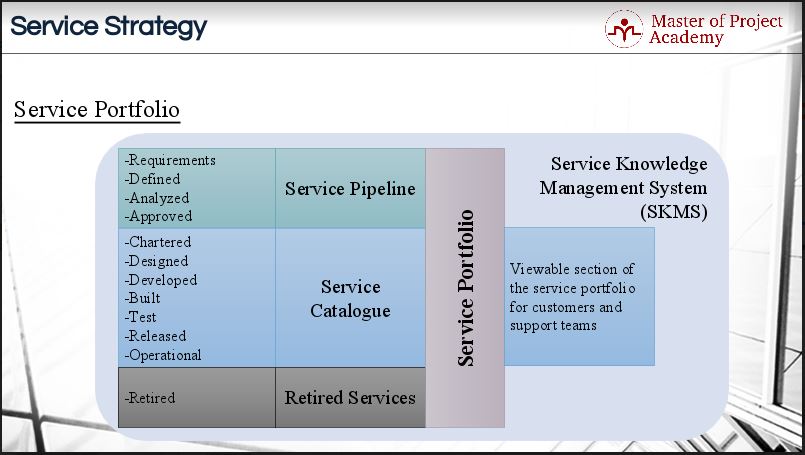According to the ITIL training library, the Service Portfolio is the complete set of all services that are managed by a Service Provider. This is used to manage the entire ITIL lifecycle of services for all services. A service can be in 3 fundamental stages through its lifecycle as discussed in ITIL Foundation training.

The service can be in the ITIL Service Design or ITIL Service Strategy stage which corresponds to Service Pipeline category of the Service Portfolio. It can be live in the ITIL Service Operation stage or available for deployment in the ITIL Service Transition stage which corresponds to the Service Catalogue category. And finally, if the service is no longer in use, it can be in Retired Services category.
Service Portfolio: Service Catalogue Category
The first part of the service portfolio is the live services or services which are available for deployment. These are the services that are the current bread and butter of the IT service provider which are accessible to the customer. And they also create value and revenue for the service provider. Such services can be in various forms of statuses:
- Chartered
- Designed
- Developed
- Built
- Tested
- Released
- Operational.
These are the services that belongs to an organization and which are used by its customers. These services are grouped under the Service Catalogue of the Service Portfolio. The services in the Service Catalogue must be closely monitored to determine whether they are still creating value for the customer. Also, whether they are still aligned with the business strategy. If this critera is not met, Continual Service Improvement steps must be taken to understand the weaknesses of the service and corrective actions must be taken. If the business directive has shifted in a different direction, these services may be moved to the Retired Service category.

Service Portfolio: Service Pipeline Category
The second category of service portfolio is the services that are planned to be developed based on the requirements of the business and as a part of the strategy. These services are important for the development of the IT service provider as a key competitor in the market. Such services may be market disrupters. The services can also be in various levels of statuses:
- Defined
- Analyzed
- Approved
These services are actually in the scope of the organization. They are planned to be designed and implemented in the future. These services are grouped under the Service Pipeline. These services are either in the Service Strategy where services that are strategically defined for creating value to the customer. Or they are in the Service Design stage where services are being designed according to specifications set during the Service Strategy stage. It is important for a service owner and a service manager to be fully informed about the status of each of the services in the Service Pipeline. This is good for effectively managing the services in these critical parts of the ITIL lifecycle.
Service Portfolio: Retired Services Category
The final category of the services is the Retired Services. These services have been used in the past but no longer in use. These services may be outdated, no longer relevant to the customer or no longer aligned with the business strategic objectives. It is still important to keep a record of retired services for future reference. Even though the services in this category are no longer in use, it is possible that learnings from each of the stages of the ITIL service lifecycle, especially the Continual Service Improvement stage, can aid the services in the Service Catalogue or the Service Pipeline services.

These three categories of services, Service Pipeline, Service Catalogue and Retired Services constitute the Service Portfolio of the organization. In summary, service portfolio includes all the future, current and past services of an organization. The Service Portfolio is stored, maintained, and updated as part of the service knowledge management system.
The Service Catalogue is available to customers and to support teams
The Service Catalogue is a database or a structured document with information about all live IT Services, including the services which are available for deployment. The Service Catalogue also includes information about deliverables, prices, contact points, ordering and request processes about live services. And the Service Catalogue is the only part of the service portfolio published to customers. It is used to support the sale and delivery of IT services. Therefore, the Service Catalogue is the only viewable part of the service portfolio to customers and to support teams. Since support teams will be receiving the queries from the customers using live services, support teams can also view the service catalog part of the service portfolio Services in the Service Pipeline and Retired Services categories cannot be viewed by the customer as these are either still in development or no longer relevant to the customer.

The services manager and service owners must have a firm grasp of the Service Portfolio and which services fall into which category. A good IT service management requires being knowledgeable about the services in each step of the ITIL Process in the Service Lifecycle as well as where the services are allocated in the service portfolio.
As the services move through the ITIL service lifecycle, the services manager and service owners must ensure that the services are categorized under the correct section of the service portfolio. The services portfolio is the dashboard from which good IT service management can get a bird’s eye view of all the services in the company: the past, present, and future.

3 thoughts on “Service Portfolio: A bird’s eye view of your IT services”
Comments are closed.